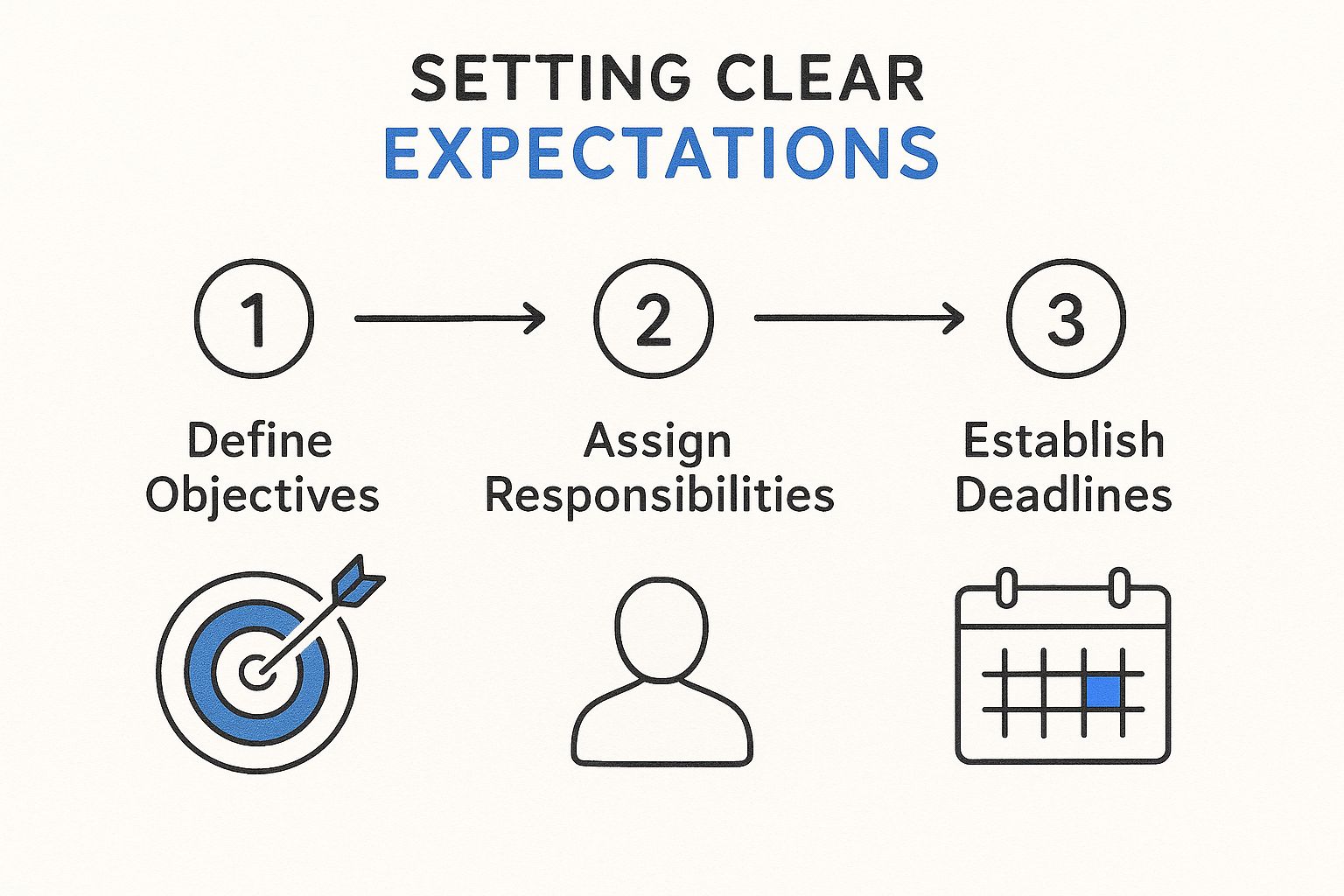
How to Manage Remote Teams: Proven Strategies for Success
Learn how to manage remote teams effectively with expert tips and strategies. Discover proven methods to enhance productivity and collaboration remotely.

Successfully managing a remote team isn't something you can improvise. From my experience, it boils down to intentional design—a framework built on deliberate communication, reliable systems, and a culture of trust over surveillance. This guide is a practical roadmap to help you lead your team to success, no matter where they are.
The Foundation for Successful Remote Leadership

Welcome to the new standard for leadership. Knowing how to manage a remote team is no longer a "nice-to-have" skill; it's absolutely essential for growing your business and keeping your best people. The shift to distributed work isn't a fleeting trend—it's an enduring change in how we work.
The numbers don't lie. As of 2023, roughly 28% of employees worldwide worked fully remotely. That's a huge jump from just 20% in 2020. And with a staggering 91% of employees saying they want remote or hybrid options, it’s crystal clear that mastering virtual leadership is critical. If you want to dive deeper into the data, Splashtop’s recent findings on remote work trends offer some great insights.
This guide will cut through the noise and give you the core pillars for building a high-performing, happy distributed team.
Core Pillars of Remote Team Management
We've found that success in remote management really comes down to mastering four key areas. Think of them as the pillars holding up your entire remote work structure. Getting these right creates a cohesive, productive, and genuinely connected environment.
Here's a quick look at the core strategies we'll be breaking down in this guide. Each one plays a vital role in building a team that thrives.
| Pillar | Key Action | Impact on Team |
|---|---|---|
| Precise Communication | Define which tools are used for which conversations. | Reduces digital noise and creates clarity. |
| Outcome-Focused Goals | Shift focus from tracking hours to measuring results. | Empowers autonomy and high-quality work. |
| The Right Technology | Adopt an integrated tech stack (e.g., Kanban in Gmail). | Centralizes workflows and boosts efficiency. |
| Active Engagement | Intentionally build connections and a supportive culture. | Prevents isolation and boosts morale. |
These pillars provide a solid foundation for any leader aiming to excel in a remote setting. We'll explore each one in detail, giving you actionable steps to implement them effectively.
The core challenge is clear: effective remote management requires deliberate action. It's about building systems that foster clarity and connection, enabling your team to perform at their best regardless of location.
These pillars are your starting point for building a strong, successful remote team. For a more comprehensive look at virtual leadership, you might also want to explore these effective strategies for managing remote teams. By focusing on these principles, you can create an environment where everyone feels connected, valued, and genuinely empowered to do great work.
Designing Your Communication Operating System
In a remote team, great communication is something you build, not something that just happens. You can't simply tell people to "communicate more" and hope for the best. It doesn't work. Instead, you need a deliberate framework—think of it as a communication operating system—that clearly defines how information flows.
This means assigning specific channels for specific types of conversations. Doing this cuts down on confusion and the digital fatigue that comes from being pinged everywhere at once.
For instance, your system might look something like this:
- Slack/Teams: For quick, informal questions and rapid-fire updates that don't need to be saved forever.
- Asana/Trello Comments: Reserved for direct feedback and notes on specific tasks. This keeps all the context right where the work is happening.
- Email: Designated for more formal announcements, any communication with clients, and official documentation.
- Video Calls: Prioritized for one-on-ones, brainstorming complex problems, and just building that personal connection that's so easy to lose when you're remote.
Create Asynchronous Clarity
One of the biggest hurdles in managing a remote team is getting asynchronous work right. This isn't about getting rid of meetings entirely, but about making them count by documenting key decisions where everyone can see them. After a call, posting a quick summary in the relevant project channel ensures everyone is on the same page, no matter their time zone.
If you want to go deeper on setting up these kinds of clear guidelines, exploring different remote team communication strategies can really help. There are some great resources out there with practical advice for building a system that fits your team’s unique rhythm.
This simple infographic breaks down the core process for establishing clear expectations on any task or project.

It’s a great visual reminder of how important it is to define what needs to be done, who owns it, and when it's due. This is how you build real accountability from the start.
Integrate Tools for a Visual Workflow
Bringing your tools together is what makes a communication system truly seamless. Instead of constantly asking, "What's the status on that?" you can build visual workflows that give you the answer at a glance. For example, a lot of teams I've worked with have found huge success by bringing their task management directly into their main communication hub, like Gmail.
A common mistake is treating communication and project management as two separate things. The most effective remote teams weave them together, so the work and the conversation about the work happen in the same place.
A Kanban board is a perfect example of this. It’s a simple, visual tool for seeing your workflow in real-time.

The columns—To Do, In Progress, Done—give you instant clarity on where every project stands. This simple view dramatically reduces the need for those "just checking in" meetings.
When you design a system that combines assigned channels with integrated visual tools, you create a self-sustaining operating system for remote work. This thoughtful approach isn't just a "nice to have"; it's the foundation for managing remote teams successfully.
Driving Performance Without Micromanagement

When your team is spread out, how do you make sure everyone is accountable? The real secret is to stop worrying about if they're working and start focusing on what they're delivering.
This is probably the single most important mental shift for any leader managing a remote team. Moving from "Are they busy?" to "Are they making an impact?" builds a foundation of trust and gives your team the autonomy they need to do their best work.
Instead of arbitrary oversight, you need a clear, structured way to set goals. This is where a framework like Objectives and Key Results (OKRs) really shines. It forces you to get crystal clear by connecting the big-picture goals (the Objectives) with the specific, measurable outcomes that define success (the Key Results).
Setting Up Remote-Friendly OKRs
In a remote setup, OKRs act as a public North Star. Everyone on the team, no matter their time zone, can see what the collective goal is. This transparency eliminates the need for all those "just checking in" meetings that kill productivity.
Here's what it looks like in practice:
- Objective: This is your high-level, aspirational goal. Think qualitative, not quantitative. For example: Launch the new client onboarding portal to improve initial user success.
- Key Results: These are the measurable milestones that prove you’ve achieved your objective. For example: Achieve a user satisfaction score of 90% or higher on post-onboarding surveys. Or, Reduce support tickets related to setup by 40% within the first quarter.
This structure gives your team clear targets. They know exactly what winning looks like, but they have the freedom to figure out the best way to get there. That's infinitely more motivating than having every step dictated to them.
The most powerful shift in remote management is from supervising tasks to championing outcomes. When you give your team a clear destination and the autonomy to navigate, you don't need to micromanage the journey.
Rhythms for Supportive Check-Ins
Accountability doesn’t come from constant surveillance. It comes from creating a predictable rhythm of supportive check-ins and reviews. This gives you visibility without making your team feel like they’re under a microscope. A weekly one-on-one focused on clearing roadblocks, paired with a monthly review of OKR progress, is often all it takes to keep everyone aligned.
Celebrating wins is just as important for morale. A dedicated Slack or Teams channel for "shout-outs" creates a powerful, positive feedback loop. When someone ships a tough feature or gets glowing client feedback, making that win public doesn’t just feel good—it shows the whole team what excellence looks like.
This focus on results is becoming more crucial as companies navigate new workforce dynamics. If you're interested in the broader trends, this mid-year analysis on global hiring and remote work dynamics offers some great insights.
Ultimately, driving performance remotely is all about building systems of transparency. When the goals are clear and progress is visible to everyone, accountability stops being a top-down mandate and becomes a shared responsibility.
Building a Thriving Remote Work Culture
When your team is scattered across different cities or even time zones, company culture isn't built with ping-pong tables and free snacks. It's the invisible glue holding everything together, and in a remote setting, you have to create that glue intentionally.
Without a deliberate effort to foster connection, isolation can set in fast, dragging down morale and productivity. A strong remote culture is built on a foundation of trust, psychological safety, and genuine human connection. It's what separates a team of disconnected freelancers from a cohesive unit driving toward a shared mission. The good news? You can absolutely shape and nurture this culture, no matter where your team logs in from.
Go Beyond Forced Fun
Let's be honest: virtual team building often gets a bad rap. That's usually because it feels forced, awkward, or like just another mandatory meeting on the calendar. The trick is to move beyond cringe-worthy happy hours and find activities that spark natural collaboration and conversation.
Think about activities that cater to different personalities and interests:
- Try collaborative challenges. Things like online escape rooms or cooperative puzzle games get people working together and problem-solving in a low-stakes, fun environment. It builds rapport without anyone even realizing it.
- Create a digital "water cooler." Set up a dedicated channel in Slack or Microsoft Teams for non-work chat. This is the place for sharing hobbies, pet photos, or weekend plans—the kind of spontaneous conversations that build relationships in an office.
- Encourage peer-to-peer recognition. A public channel where team members can shout out each other's wins is incredibly powerful. It fosters a culture of appreciation and makes everyone feel seen for their contributions.
We've put together a few ideas to get you started on building connection and morale virtually.
Remote Culture-Building Activities
Here’s a look at a few virtual team-building activities, their goals, and the tools you might need to pull them off.
| Activity Idea | Primary Goal | Tools Needed | Frequency |
|---|---|---|---|
| Virtual Escape Room | Collaborative problem-solving | Platforms like The Escape Game or custom-built puzzles on Miro/Mural | Quarterly |
| Show and Tell | Personal connection | Video conferencing tool (Zoom, Google Meet) | Monthly |
| Peer Recognition Channel | Build appreciation & morale | Slack, Microsoft Teams | Ongoing/Daily |
| Virtual Coffee/Lunch | Informal social interaction | Video conferencing tool, optional food delivery stipend | Weekly/Bi-weekly |
| Hobby & Interest Groups | Community building | Dedicated chat channels (e.g., #book-club, #gamers) | Ongoing |
Finding the right mix of activities helps ensure there's something for everyone, making culture-building feel inclusive rather than like a chore.
Support Well-Being and Flexibility
A healthy remote culture is one that fiercely protects employee well-being. It all starts with respecting boundaries. You have to encourage your team to fully disconnect after their workday—and, just as importantly, you need to model that behavior yourself.
This also means embracing flexibility. When you trust your team to manage their own time effectively, it becomes a massive driver of motivation and loyalty. This isn't just a nice-to-have anymore; it's a critical factor in retaining top talent. After all, recent studies show that 83% of the global workforce prefers a hybrid or fully remote model. As you can see from these remote work statistics, nearly half of all employees would consider quitting if forced back into a full-time office. A supportive remote culture is simply non-negotiable today.
The strongest remote cultures are built on a foundation of empathy and trust. They prioritize people's well-being, celebrate both professional and personal milestones, and create a safe space for open conversations about mental health.
Creating this supportive environment also means empowering your team with the right physical setup. For tips on creating a focused space at home, check out our guide on how to create a productive workspace. It's a small but meaningful way to show you care about their entire work experience.
Ultimately, building a thriving remote culture is about making people feel seen, heard, and connected. Get this right, and you’ll create an environment where your team can do their best work and feel great doing it.
Choosing and Integrating Your Remote Tech Stack

Let's be honest: the right technology can feel like a superpower for a remote team. But a messy, disconnected set of tools? That just creates constant friction and a whole lot of frustration.
Building a solid remote tech stack isn't about chasing the trendiest apps. It's about designing a seamless ecosystem where work flows logically from one place to the next. When your stack is a jumble of apps that don't talk to each other, your team is stuck constantly switching tabs, copy-pasting info, and losing valuable context along the way.
When you're figuring out how to manage remote teams effectively, think consolidation. The real goal is to build a "single pane of glass"—one primary place where most of the work can be seen and managed. This cuts through the digital noise and keeps everyone focused.
Core Components of a Remote Tech Stack
While every team is a little different, most great remote tech stacks are built around a few core pillars. The trick is to pick tools that not only do their job well but also play nicely with others.
Communication Hub: This is your team's digital office. Sure, tools like Slack or Microsoft Teams are the usual suspects, but the real magic happens when they're hooked into your other apps, pulling in notifications and updates automatically.
Project Management Tool: Think of this as your mission control for who's doing what, and when. Whether it's Asana, Trello, or Jira, it needs to give you a clear, visual map of all your projects.
Centralized Knowledge Base: This is your team's single source of truth. A tool like Notion or Confluence is where you house company processes, onboarding guides, and project briefs. A well-maintained knowledge base drastically cuts down on those repetitive "Where do I find...?" questions.
Smart integrations are the glue holding this all together. For example, connecting your project management tool to your communication hub can automatically post task updates to the right channel, keeping everyone in the loop without anyone having to lift a finger.
A powerful tech stack isn't just a collection of apps; it's an integrated system designed to minimize friction. The best choices are the ones that work so well together your team barely notices they exist.
Bringing Your Workflow into One Place
One of the most powerful strategies I've seen is centralizing your workflow inside an environment your team already lives in every day. And for most of us, that's our email inbox.
Instead of treating your inbox like a separate silo, you can transform it into a genuine productivity hub. This is where tools that bring project management directly into your email client become absolute game-changers.
Imagine turning an email into a task, assigning it to a team member, and tracking its journey on a shared Kanban board—all without ever leaving Gmail. This approach brilliantly merges communication with action, which is a massive win for remote efficiency. If your team is deep in the Google ecosystem, it's worth exploring the various Google Workspace productivity tools to find new ways to bring your workflows together.
When you thoughtfully choose and connect your tools, you create an environment that actually supports your team. You get rid of the annoying bottlenecks and free everyone up to focus on the work that truly matters.
Common Questions on Managing Remote Teams
Even with the best systems in place, you’re still going to hit some tricky situations when managing a remote team. It’s just part of the job. Navigating these challenges comes down to a mix of clear policies and, just as importantly, empathetic leadership. This section tackles some of the most common questions I hear from managers, with practical answers to help you handle these moments with confidence.
How Do I Build Trust With Team Members I Rarely See?
Building trust when you're not in the same room is an active, deliberate process. It doesn't just happen; you have to earn it with every single interaction.
It all starts with being reliable. Simple as that. When you say you'll do something, you do it. This creates a foundation of dependability that your team can count on, which is the bedrock of trust.
From there, it’s about open communication. Don't just tell your team what is happening; explain why it's happening. Giving them that context makes them feel like partners in the mission, not just cogs in a machine. And when you give them real autonomy over their work, you’re showing them you trust their judgment and expertise.
The fastest way to build trust is to give it first. Empower your team to own their work, make decisions, and take calculated risks. When they see you trust them, they are far more likely to trust you in return.
Make your one-on-one meetings count. These shouldn't just be status updates. Dedicate that time to their growth, their challenges, and their well-being. It's your single best opportunity to build personal rapport, which directly strengthens professional trust. Finally, don’t forget the human element. A simple "hobbies" or "weekend-wins" channel on Slack can go a long way in building the relationships that hold a team together.
What Is the Best Way to Handle Conflict on a Team?
When you’re remote, conflict can escalate in the blink of an eye. A sarcastic comment in a chat that would be laughed off in person can easily be misinterpreted as a personal attack when you can't see the person's face. The key is to jump on friction immediately and move the conversation to a better medium.
If you spot tension simmering in an email thread or Slack channel, your first move should always be to get the folks involved on a video call. This one simple step can de-escalate things almost instantly by reintroducing tone of voice and facial expressions.
If you need to step in and mediate, schedule a video meeting with everyone and lay down some ground rules:
- Focus on the issue, not the person. Keep the conversation centered on the work, not on personalities.
- Use "I feel" statements. Encourage everyone to own their perspective without placing blame.
- Listen to understand, not to reply. Make sure each person gets to speak without being cut off.
Once you’ve reached a resolution, write down the agreement and share it privately. It’s also a great idea to check in a day or two later, just to make sure things are truly repaired and the solution is sticking. For a deeper dive, exploring in-depth remote work guides can provide some excellent additional perspectives.
How Can I Fairly Evaluate Employee Performance?
Evaluating performance fairly in a remote setup has to be about outcomes, not perceived activity. Let's be clear: tracking online status indicators or keystrokes is not only a waste of time, but it’s also a fantastic way to destroy trust. The focus has to be on tangible results.
Start by implementing a clear goal-setting framework, like OKRs or SMART goals. This gives everyone on the team a precise, shared understanding of what success actually looks like for their role. Use your project management tools to track progress against these goals transparently, so everyone can see how their individual work connects to the team's bigger objectives.
When it's review time, you need a holistic picture. Combine the hard numbers (features shipped, targets met, tickets closed) with qualitative feedback from peers and collaborators. This 360-degree view ensures you're valuing real impact over who just happens to be the most visible in Slack. This whole process is tied directly to how well you assign work in the first place; for a deeper look, our article on how to delegate tasks effectively offers a structured approach.
How Do You Prevent Burnout and Isolation?
You can't just hope burnout and isolation won't happen. As a leader, you have to be proactive and intentional about preventing them.
It starts with you. Model and enforce healthy work-life boundaries. This means defining core collaboration hours and actually respecting "offline" time. When your team sees you logging off at a reasonable hour, it gives them permission to do the same.
Champion mental well-being by offering genuine flexibility. Let people work when they're most productive and manage their personal lives. To fight off isolation, you have to create structured (but optional!) chances for social connection. This could be anything from:
- A daily "good morning" thread that has nothing to do with work.
- Virtual coffee breaks scheduled right on the calendar.
- Team-based online games or activities.
Again, your one-on-ones are your most critical tool here. Use them as a dedicated time to check in on someone's morale and workload. Create a safe space where they can be honest about their struggles before they snowball into bigger problems.